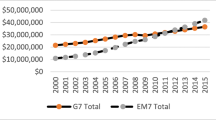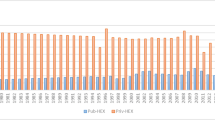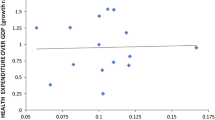Abstract
World Bank and Russian Federal State Statistics Service data were used to analyze cross-country correlations between life expectancy (LE) and per capita gross domestic product (GDP). The trends detected upon comparisons across different countries (the Preston curve) or regions of the Russian Federation (RF) in 2015 were compared. In addition, the correlations between the same parameters related to different years, from 1960 to 2015, were examined in each of several selected countries representing the upper and lower extremes of GDP and LE. The same has been done with LE vs. per capita health care spending (HCS). In all cases, the points related to the RF are located significantly lower than the respective regression lines (Preston curves) built based on all points. The LE vs. GDP and LE vs. HCS plots and their extrapolations constructed based on data related to different years in the same country run markedly lower for the RF as compared with other countries, including Tajikistan and the Republic of Congo. At the same time, the ratio of GDP and HCS has been shown to be the same throughout all years and all countries. Taken together, these observations suggest that the effectiveness of investing available resources in LE, i.e., in the quality of human life, is markedly lower in RF as compared not only with Finland and Japan, where GDP and HCS are several times greater but also with Congo and Tajikistan, where these parameters are several times smaller than in the RF. This means that in the RF, it is impossible to increase LE up to 80 years, which has been declared a national priority, merely by increasing GDP and HCS. Identification of the factors responsible for the above disproportions is beyond the scope of the present paper. However, the mere awareness of their existence is essential as an incentive to take special efforts aimed at the identification and neutralization of these factors.








Similar content being viewed by others
Notes
http://www.gks.ru/wps/wcm/connect/rosstat_main/rosstat/ru/ statistics/publications/catalog/doc_1138623506156.
REFERENCES
Ahrenfeldt, L.J., Moller, S., Andersen-Ranberg, K., et al., Religiousness and health in Europe, Eur. J. Epidemiol., 2017, vol. 32, pp. 921–929.
Bloom, D.E. and Canning, D., Commentary: The Preston Curve 30 years on: still sparking fires, Int. J. Epidemiol., 2007, vol. 36, pp. 498–499.
Burtscher, M., Effects of living at higher altitudes on mortality: a narrative review, Aging Dis. 2014, vol. 5, pp. 274–280.
Dalgaard, C.-J. and Strulik, H., Optimal aging and death: understanding the Preston curve, J. Eur. Econ. Assoc., 2014, vol. 12, pp. 672–701.
Dong, X., Milholland, B., and Vijg, J., Evidence for a limit to human lifespan, Nature, 2016, vol. 538, pp. 257–259.
Edwards, R.B., Mining away the Preston curve, World Dev., 2016, vol. 78, pp. 22–36.
Finch, C.E. and Pike, M.C., Maximum life span predictions from the Gompertz mortality model, J. Gerontol. A, 1996, vol. 51, pp. B183–194.
Golubev, A., How could the Gompertz-Makeham law evolve, J. Theor. Biol., 2009, vol. 258, pp. 1–17.
Golubev, A.G., Greenhouse gases, culture traditions and life expectancy: history and geography, Biosfera, 2012, vol. 4, pp. 474–487.
Golubev, A., Hanson, A.D., and Gladyshev, V.N., Non-enzymatic molecular damage as a prototypic driver of aging, J. Biol. Chem., 2017, vol. 292, pp. 6029–6038.
Golubev, A., Hanson, A.D., and Gladyshev, V.N., A tale of two concepts: Harmonizing the free radical and antagonistic pleiotropy theories of aging, Antioxid. Redox Signaling, 2017. https://doi.org/10.1089/ars.2017.7105
Golubev, A.G., Biochemistry of lifespan extension, Usp. Gerontol., 2003, no. 12, pp. 57–76.
Golubev, A.G., Evolution of lifespan and ageing, Biosfera, 2011, vol. 3, pp. 338–368.
Golubev, A.G., The issue of the feasibility of a general theory of aging. III. Theory and practice of aging, Adv. Gerontol., 2012, vol. 2, no. 2, pp. 109–119.
Golubev, A.G., Commentary: Is life extension today a Faustian bargain? Front. Med., 2018, vol. 5, no. 73. https://doi.org/10.3389/fmed.2018.00073
Gurven, M. and Fenelon, A., Has actuarial aging “slowed” over the past 250 years? A comparison of small-scale subsistence populations and European cohorts, Evolution, 2009, vol. 63, pp. 1017–1035.
Kowald, A. and Kirkwood, V.B., Can aging be programmed? A critical literature review, Aging Cell, 2016, vol. 15, pp. 986–998.
Marck, A., Antero, J., Berthelot, G., et al., Are we reaching the limits of Homo sapiens? Front. Physiol., 2017, vol. 8, no. 812. https://doi.org/10.3389/fphys.2017.00812
Modig, K., Andersson, V., Vaupel, J., et al., How long do centenarians survive? Life expectancy and maximum lifespan, J. Int. Med., 2017, vol. 282, pp. 156–163.
Petrascheck, M. and Miller, D., Computational analysis of lifespan experiment reproducibility, Front. Genet., 2017, vol. 30, no. 8, p. 92. https://doi.org/10.3389/fgene.2017.00092
Poulain, M., Herm, A., and Pes, G., The Blue Zones: areas of exceptional longevity around the world, in The Vienna Yearbook of Population Research, Vienna: Vienna Inst. Demogr., Austrian Acad. Sci., 2013, vol. 11, pp. 87–108.
Preston, S.H., The changing relation between mortality and level of economic development, Popul. Stud., 1975, vol. 29, pp. 231–248.
Thiersch, M., Swenson, E.R., Haider, V., and Gassmann, M., Reduced cancer mortality at high altitude: The role of glucose, lipids, iron and physical activity, Exp. Cell Res., 2017, vol. 356, pp. 209–216.
Wang, S., Luo, K., Liu, Y., et al., Economic level and human longevity: Spatial and temporal variations and correlation analysis of per capita GDP and longevity indicators in China, Arch. Gerontol. Geriatr., 2015, vol. 61, pp. 93–102.
Williams, G.C., Pleiotropy, natural selection and the evolution of senescence, Evolution, 1957, vol. 11, pp. 398–411.
Wilmoth, J.R., Deegan, L.J., Lundström, H., and Horiuchi, S., Increase of maximum life-span in Sweden, 1861–1999, Science, 2000, vol. 289, pp. 2366–2368.
Zimmer, Z., Jagger, C., Chiu, C.-V., et al., Spirituality, religiosity, aging and health in global perspective: a review, SSM–Popul. Health, 2016, vol. 2, pp. 373–381.
Zubieta-Calleja, G. and Zubieta-DeUrioste, N., Extended longevity at high altitude: Benefits of exposure to chronic hypoxia, BLDE Univ. J. Health Sci., 2017, vol. 2, no. 2, pp. 80–90.
Author information
Authors and Affiliations
Corresponding author
Ethics declarations
Conflict of interest. The authors declare that they have no conflict of interest. Statement of the welfare of animals. This article does not contain any studies involving animals or human participants performed by any of the authors.
Additional information
“By the end of the next decade, Russia must with confidence join the Club of countries where life expectancy exceeds 80 years…”
from the Presidential Address to the Federal Assembly of the Russian Federation, March 1, 2018
Translated by A. Dunaeva
Rights and permissions
About this article
Cite this article
Golubev, A.G. Where Does the Preston Curve Lead Us?. Adv Gerontol 9, 115–125 (2019). https://doi.org/10.1134/S2079057019020103
Received:
Revised:
Accepted:
Published:
Issue Date:
DOI: https://doi.org/10.1134/S2079057019020103




